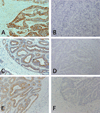The type III inositol 1,4,5-trisphosphate receptor is associated with aggressiveness of colorectal carcinoma
- PMID: 21075448
- PMCID: PMC3572849
- DOI: 10.1016/j.ceca.2010.09.005
The type III inositol 1,4,5-trisphosphate receptor is associated with aggressiveness of colorectal carcinoma
Abstract
The inositol 1,4,5-trisphosphate receptor (InsP3R) mediates Ca(2+) signaling in epithelia and regulates cellular functions such as secretion, apoptosis and cell proliferation. Loss of one or more InsP3R isoform has been implicated in disease processes such as cholestasis. Here we examined whether gain of expression of InsP3R isoforms also may be associated with development of disease. Expression of all three InsP3R isoforms was evaluated in tissue from colorectal carcinomas surgically resected from 116 patients. Type I and II InsP3Rs were seen in both normal colorectal mucosa and colorectal cancer, while type III InsP3R was observed only in colorectal cancer. Type III InsP3R expression in the advancing margins of tumors correlated with depth of invasion, lymph node metastasis, liver metastasis, and TNM stage. Heavier expression of type III InsP3R also was associated with decreased 5-year survival. shRNA knockdown of type III InsP3R in CACO-2 colon cancer cells enhanced apoptosis, while over-expression of the receptor decreased apoptosis. Thus, type III InsP3R becomes expressed in colon cancer, and its expression level is directly related to aggressiveness of the tumor, which may reflect inhibition of apoptosis by the receptor. These findings suggest a previously unrecognized role for Ca(2+) signaling via this InsP3R isoform in colon cancer.
Copyright © 2010. Published by Elsevier India Pvt Ltd.
Conflict of interest statement
There are no conflict of interest to disclose for all authors.
Figures





References
-
- Stewart BK, Kleihues P. World Cancer Report, World Health Organization, International Agency of Research on Cancer. Lyon: IARC Press; 2003. Colorectal Cancer.
-
- Taketo MM, Edelmann W. Mouse models of colon cancer. Gastroenterology. 2009;136:780–798. - PubMed
-
- Mendes CC, Gomes DA, Thompson M, et al. The type III inositol 1, 4,5-trisphosphate receptor preferentially transmits apoptotic Ca2+ signals into mitochondria. J. Biol. Chem. 2005;280:40892–40900. - PubMed
Publication types
MeSH terms
Substances
Grants and funding
LinkOut - more resources
Full Text Sources
Other Literature Sources
Medical
Miscellaneous

